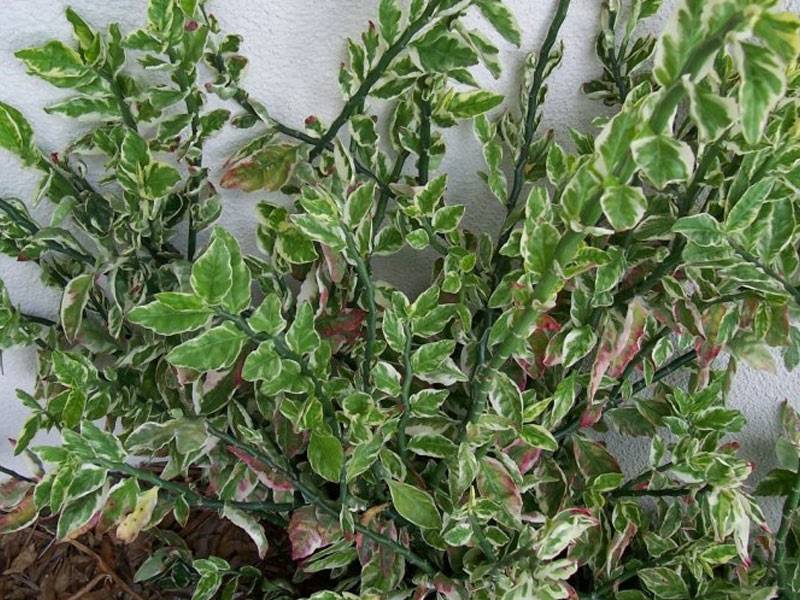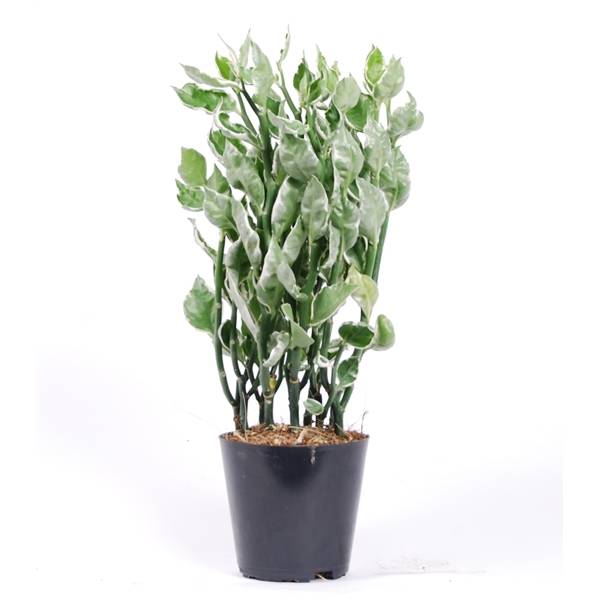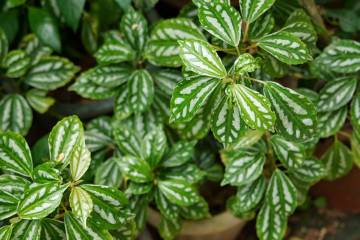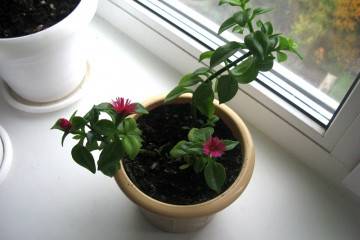Pedilanthus titimaloid - care and reproduction of a houseplant
Content:
Indoor flower pedilanthus titimaloid with a lush crown and decorative leaves of an elegant color is similar to an artificial composition. Its leaves and small flowers with bright bracts are covered with a waxy coating and therefore seem too smooth and shiny, as if made of plastic. Florists love a persistent and hardy plant called titimaloid pedilanthus for its unpretentious disposition, as well as its exotic appearance. Caring for him is very simple, but you need to know some of the nuances.
Pedilanthus: a general description of the plant
The species Pedilanthus Titimaloid belongs to the genus Pedilanthus, which is included in the Euphorbia family.
When cut, it secretes milky juice, which irritates the mucous membranes and skin. That is why all manipulations with the plant must be carried out with gloves, and also place it out of the reach of children and pets.
Pedilanthus is an evergreen perennial with long dark green or grayish cylindrical stems and pointed leaves 10 cm long and 3 cm wide. Depending on the variety and type, the leaves are oval or elongated, with smooth or wavy edges, green, light green and olive. With age, the stems lose their decorative effect, their lower part is exposed.
In their natural environment, pedilanthuses are found in North, Central and South America. And the appearance of a plant depends on its proximity to the equator.
- In arid areas, the plant has a thickened, water-storing stem with little or no leaves.
- In warm and humid tropical forests, pedilanthuses grow in the form of shrubs or small trees with dense foliage, spectacular flowers. Such a tree can reach 3 meters in height.
The average size of indoor specimens is 60-80 cm, but the pedilanthus is able to stretch up to 1.5 meters, if conditions permit. In an adult specimen, the stems are resilient, so the plant can be grown without additional support.
Small pink pedilanthus flowers in shape resemble pointed shoes, so the plant received a beautiful name, derived from the Greek words "shoe" and "flower".
Varieties of indoor plants
In nature, there are about 15 species of the genus Pedilanthus. In indoor floriculture, only a few varieties are grown, which will be discussed below.
Large-fruited Pedilanthus (Pedilanthus macrocarpus)
Evergreen shrub with straight stems directed straight up. Stems are thick, fleshy, little branching, round or flat in shape, pale green or grayish in color. They are covered with a waxy substance.
Leaves are missing. Instead, small scaly growths are located along the entire length of the stems.During the flowering period, the large-fruited pedilanthus resembles a candle in appearance: straight bare stems are crowned with red or orange pointed buds.
The flowers are typical in shape for all pedilanthuses: they are tiny glossy "shoes". The large-fruited pedilanthus comes from the arid Mexican deserts. Due to its succulent properties, it is able to accumulate moisture and easily tolerates short drying.
Pedilanthus tithymaloides
In indoor floriculture, this is the most common type. It is unpretentious, does not require special care, reproduces well, and due to the interesting color of the leaves and the zigzag shape of the stems, it has high decorative properties.
At home, titimaloid pedilanthus is grown in the form of a bush. It branches reluctantly, therefore, to achieve decorativeness, 3-5 plants are planted in a pot.
The leaves are shiny, elongated, with a pointed tip, basically green.
Pedilanthus finkii
Stems are zigzag, long, strong and resilient, bare along their entire length. The leaves of the Finka pedilanthus are present only on the tops of the stems. In color, the leaf plates in most varieties are green, with a uniform color. The shape is pointed, elongated with a characteristic wax coating.
Titimaloid pedilanthus: home care
The flower is photophilous, so it should be kept on the windowsill of the southern, southeastern and southwestern windows. For variegated varieties, the level of illumination is especially important, since with a lack of light, variegated leaves lose their decorative effect.
However, from too aggressive sunlight, the plant can get burned. Therefore, in the spring-summer period, the flower, located on the southern windowsill, is shaded at midday or transferred into the interior of the room.
The optimum temperature for growing is 20-25 degrees in summer and 14-16 degrees in winter. The plant is afraid of drafts, but loves fresh air, so in summer it is recommended to take it out of the house to the garden or to the balcony, and in winter to ventilate the room, protecting the flower from cold air.
The flower requires a slightly acidic or neutral soil mixture, loose, light in structure, which can be purchased in the store (soil for succulents) or prepared independently from turf and leafy soil with the addition of river sand in equal proportions. When using soil taken from the garden, it must first be disinfected (calcined in the oven or freeze on the street).
To achieve looseness and prevent stagnation of water in an earthen coma, perlite, vermiculite, and charcoal are added to the soil mixture.
He is equally afraid of overdrying an earthen coma and overflow of moisture. When the soil becomes acidic, the weak root system rots, and the plant risks dying. When dry, in order to save energy to support life, it sheds foliage, which, when favorable conditions are restored, grows back.
In summer, abundant regular watering is required with soft warm, settled or filtered water at room temperature. In winter, watering is reduced to a minimum (once every 1-2 weeks). Water for irrigation can be slightly warmed up.The frequency depends on the location of the flower and the ambient humidity. Dry air is difficult for the plant, so in winter it is recommended to spray it periodically or install a container with wet expanded clay next to the pot.
It is better to choose the irrigation schedule for your pedilanthus yourself, focusing on the state of moisture of the substrate - in summer the soil should be slightly moist, and in winter the upper layers of the soil should have time to dry out.
Titimaloid pedilanthus responds positively to water procedures, including bathing in the shower and wiping sheet plates. After washing, the leaves become brighter, the plant starts growing. Water procedures can be arranged all year round, but in summer, as a rule, more often - at least once a month.
Slow growth, overly elongated stems, unhealthy foliage and lack of flowering indicate a lack of nutrients. In this case, it is recommended to feed the plant.
Fertilizers for pedilanthus titimaloid
Home care involves fertilizing. For this, fertilizers are used with a minimum proportion of nitrogen and the required content:
- iron (takes part in metabolic processes);
- phosphorus (necessary for the absorption of mineral supplements);
- calcium (needed to strengthen the cellular structure, to normalize phosphorus and nitrogen metabolism).
Usually, feeding is carried out with complex liquid mineral fertilizers for indoor plants and succulents from spring to autumn, once a month.
Pruning and replanting
Pedilanthus titimaloid branches reluctantly and, if it is not cut at all, the elongated stems will do just fine without lateral processes. Pruning should be done regularly to stimulate the branching process.
They are rarely transplanted, as the root system grows in the spring before the start of active growth. Once the roots of the plant have braided the drainage holes of the pot, it is time to transplant.
Due to the undeveloped root system, deep pots are not recommended for pedilanthus. When transplanting, it is necessary to select a pot 2-3 cm larger than the previous one.
If desired, you can renew the topsoil in the pot by removing and filling in the required amount of soil.
Flowering features
At the end of autumn, titimaloid pedilanthus blooms. First, a single "arrow" appears at the top of the shoot. It gradually turns into a pinkish-red "shoe" that everyone takes for a flower.
But pedilanthus, in fact, has small nondescript flowers. They are collected in inflorescences-umbrellas with 2 decorative bracts, which are all mistaken for a flower-"shoe".
After flowering, a dormant period begins. It runs from late November to March. During this time, the plant needs to rest and gain strength for the next year. The temperature is gradually reduced to 14-18 degrees, watering is reduced to a minimum, fertilizers are postponed until spring. If the plant cannot rest, then next year it will definitely not bloom.
Reproduction methods
If we talk about such a plant as pedilanthus, propagation by cuttings is the most optimal and correct solution.
To do this, use the cuttings remaining after pruning, the optimal length of which is 12-15 cm. Apical and intermediate cuttings are suitable for reproduction (if too cardinal pruning, the cut stem is divided into 2-3 pieces of the corresponding length).
How to propagate pedilanthus by cuttings? The step-by-step instruction looks like this:
- The lower leaves are removed from the cutting, exposing the base.
- To remove the milky juice, the sections are blotted with a soft napkin.
- Spread the prepared cuttings for several hours to dry. After that, they are placed in a glass with soft, settled water.
- After 10 days, the first roots will appear, and after another 2-3 weeks the young plant is ready for planting in the soil.
Titimaloid pedilanthus seeds are not propagated, since growing from seeds is too long a process and does not guarantee a positive result. In addition, pedilanthus seeds are not on sale in principle, and it is almost impossible to get ripe seeds of a tropical plant at home.
Growing problems, diseases and pests
The problems of caring for pedilanthus titimaloid are reflected in its decorative characteristics.
The main care issues are discussed below.
- Pedilanthus leaves fall, what should I do in this case? Usually he does this with insufficient watering or stagnation of water in an earthen coma. It is recommended to change the watering mode. Drafts are especially dangerous in winter. When freezing the stems, the leaves fall off.
- The lack of lighting is signaled by small leaves losing their bright color or variegated color.
- Yellowing of leaf plates, dried curled tips are the result of dry air or negative exposure to direct sunlight.
- If the plant did not bloom at the end of autumn, this means non-compliance with the temperature regime, lack of lighting, or too short a period of winter dormancy.
Such problems can be easily dealt with by changing the watering regime or moving the flower to a new place. They are not scary, because titimaloid pedilanthus is easily restored and grows foliage.
The plant pests are spider mites, aphids and whiteflies. They are removed with chemical compounds or soapy water, after cutting off the damaged foliage.
Exotically beautiful, decoratively attractive indoor plant pedilanthus titimaloid will be a wonderful decoration not only for the windowsill, but also for the interior as a whole. It will not cause trouble, and if the period of rest and good lighting is observed in summer, it will definitely bloom in autumn.





















